|
Sunday, September 02, 2007
Progress Notes
The other day Harold Flaugher (photo 1) asked me if I knew if the plans for the construction of the J.R. Wells steamboat (photo 2) still existed. Harold is a wood craftsman and wanted to make a model of this famous old steamboat which paddled up and down the Osage River in the late nineteenth and early twentieth centuries. I told him I didn't know, but that I would check around. First, I called Bamber Wright (photo 3), the only one I know now of the original family associated with the Anchor Milling Company which owned the J.R. Wells, and Bamber told me that the boat was designed by "Ship Builder Joe Shepherd of St. Louis back in the late 1800's." Further research revealed the following about the steamboat:
Name: JOHN R. WELLS
Type: Sternwheel, wooden hull towboat/packet. Size: 110.6' X 20' X 4.'
Power: 10's- 4ft. 1 boiler.
Launched: 1897, Tuscunbia, Mo. for Anchor Milling Co.
Destroyed by sinking: 1920, Jan. 30, Pelican Bend near St. Charles, Mo.,
Area of travel: Osage and Missouri Rivers. Linn Creek to St. Louis.
Owners: 1897-1909, Osage and Missouri Packet Company
Owners when sunk, Stanton and Jones
Captain: 1897-1909, John W. Adcock, first master and pilot until sold.
At one time first master and pilot was Capt. P.F. Hauenstein.
Comments: Mentioned in this Document
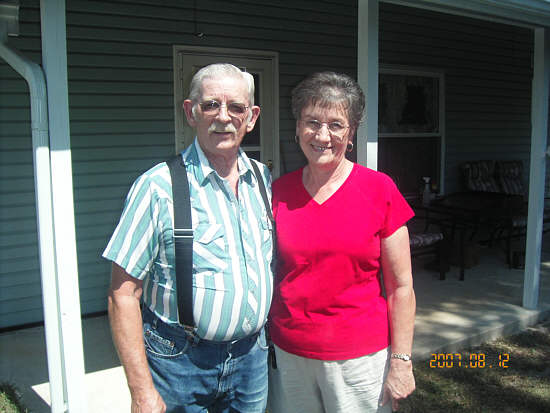 1 Harold and Joy Flaugher
 2 Steamer J.R. Wells loading firewood
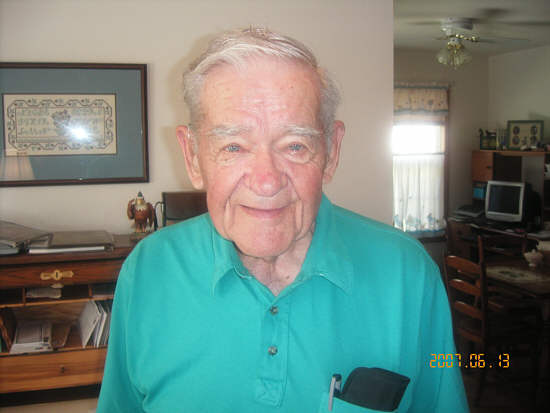 3 bamber wright june 13,2007 In my research I found one web site which is very interesting to read concerning Ozark Riverways steamboats and especially those on the Osage River:
(http://thelibrary.springfield.missouri.org/lochist/periodicals/bittersweet/wi77e.htm)
What I found especially interesting in the article contained in the above cited website is that the authors, Teresa Maddux and Ruth Massey, had interviewed Homer Clay Wright (photo 4 when Homer coached at Tuscumbia), President of Anchor Milling Company at the time the article was written back in the 1970's. Homer has since passed away but his oral history is very important as his father, C.B. Wright, not only was a past officer of the company but also was himself a steamboat captain. In brief, the following is a short history of the J.R. Wells (which was taken from our own website
(http://www.millercountymuseum.org/rivernav.html)
which I highly recommend for its thorough coverage of steamboats on the Osage River):
"In 1898, the Anchor Milling Company, desiring to expand its business, began the construction of a boat at Tuscumbia to be 110 feet long and with a 20-foot beam. This boat became known as the "J.R. Wells", so named after one of the principal stockholders of the Anchor Milling Co. This boat did an extensive business on the Osage, with Capt. John W. Adcock as pilot, later with Capt. P.F. Hauenstein. Local crews were employed on this boat, and during the boating season it was almost continuously engaged in hauling out wheat, barites, lumber, livestock, kaolin and other products as well as bringing up merchandise from Osage City and Hoecker."
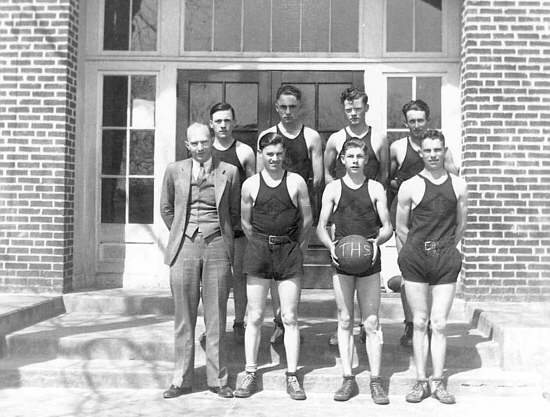 04 front: coach homer c wright , gene templeton, bill hall, alva vaughan, rear: david bear, otis nixdorf, joe wichkham, joe lamb In our museum we have a steamboat display including photos as well as a model of another of the Anchor Milling Company steamboats named after Homer C. Wright himself as well as a Pilot's Wheel and rope taken from that boat (photos 5,6,7).
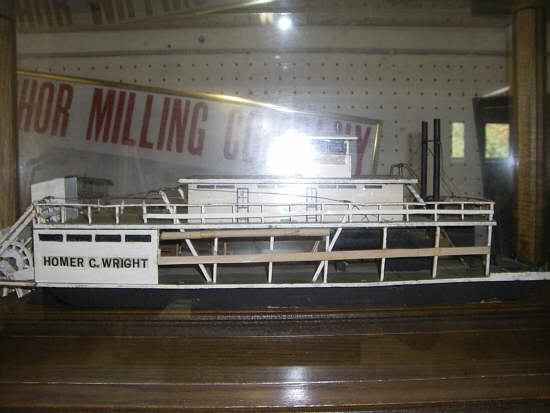 05 homer c wright
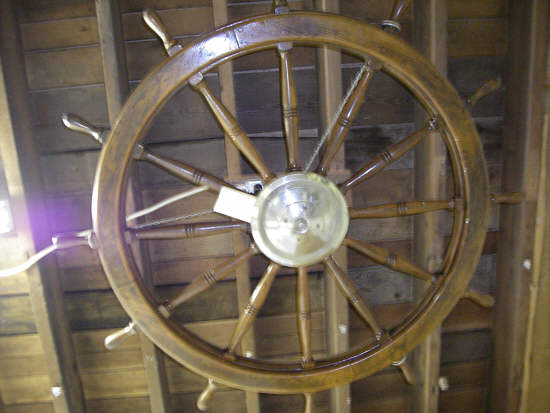 06 wheel
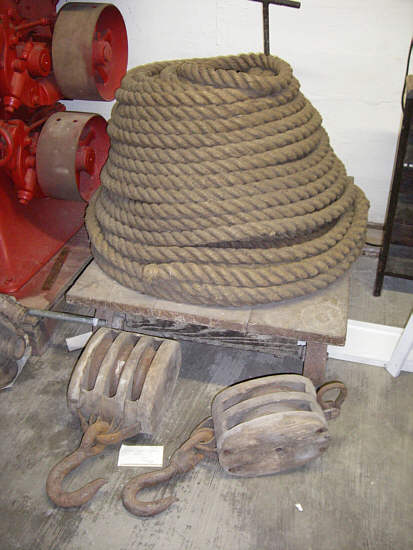 07 ship rope Tuesday of last week, I had the pleasure of being interviewed by Vicki Kramer of KRMS radio regarding our building fund campaign for the new museum addition. Vicki is a superb interviewer a very pleasant person in addition. She covered the topics of interest about the museum in an informed and interesting style. We are very grateful to her and KRMS for giving us this exposure. I don't know if the present studio is the original one; however, I did have memories of being interviewed along with other classmates of Tuscumbia High School fifty years ago by Jim Risner, former owner and manager of KRMS, as part of a feature concerning the "Planned Progress" program sponsored by Union Electric Company. Our team had won a contest for having the best proposal for our community and one of the rewards was the interview on KRMS. I remember how excited all of us were to "be on the radio".
Our museum addition is now reaching the final stages of construction. Finished is the dry wall and taping work (photos 8,9). Wall painting and floor coverings are next and should be completed in about four to five weeks at which time we will begin the job of setting up new displays in the new areas made available by the construction. We plan to have an open house next spring but we have a lot of work to do before then. We have had extra expenses, especially the cost of a new roof for the old building. So our capital campaign for the building program is ongoing. If you would like to help us with the financing of the new museum building we very much would appreciate donations of any size. Donations can be mailed to:
Miller County Museum Fund Drive
P.O. Box 57
Tuscumbia, Mo. 65082
 08 drywall lower floor
 09 drywall upper floor Last week I wrote about Helen Phillips, who with her son Don, own and operate the Phillips Funeral Home of Eldon. The subject last week was the Fendorf heritage of Helen in Tuscumbia. This week, I wanted to write about Louis's family history. William Albert Phillips (photo 10), Louis's grandfather, was born in Vermont. He fought in the Civil War but came to Eldon after the War with his wife Abigail Raymore (photo 11) who was a descendent of John Adams. William and Abigail had three children with the names John Henry, Mary Ellen and William Albert Jr. William Albert Sr., the father, died unfortunately two or three months before William Albert Jr., the son, was born. . William Albert Sr. was buried at Pleasant Mount. He had spent his time in Eldon farmng land in the general vicinity of where the present airport today is located. Some years later Abigail remarried a man named Roland Joslyn whose family also originated in Vermont but at the time was farming in Eldon. The couple decided to move to Colorado with the children where they remained for several years. Abigail and Roland had a son named Archie (photo 12) while living in Colorado. Sometime later Abigail and Roland returned as did William Albert Jr.(photo 13), the father of Louis. Later, William Albert Jr. became an employee for the R. S. Harvey lumber company which at the time also was partly owned by Henry Phillips, William Albert's uncle. Perhaps because the company made caskets, it also provided undertaking services which is the area in which William Albert worked. In 1896, he married Esther Slanker. They had three children, one of whom was Louis (photo 14), who was born in 1906. While working at R.S. Harvey William Albert Jr.(referred to locally in Eldon as Allee) became interested in the mortuary profession and decided to attend morticians' school in St. Louis getting his license as a mortician in 1906, the same year Louis was born. After completing school in Eldon, Louis decided he would like to join his father in the profession of mortuary so he traveled to Kansas City to attend a mortician's school getting his license in 1930. In 1932 William Albert Jr. bought out the mortuary part of the business from Harvey and established a funeral home across the street from the First Baptist Church (photo 15). Soon afterward Louis and Helen were married in 1933. In 1936 Louis and William Albert Jr. purchased the old R.S. Harvey home on Oak street (photo 16) which had been constructed originally in 1894. Three additions have been made to the structure since then. William Albert Jr. passed away in 1945 ( photo 17 obituary) but Louis and Helen continued the operation of the funeral home and after Louis's death in 1978 Helen and her son Don continued the management (photo 18 of Don and Helen with narrative).
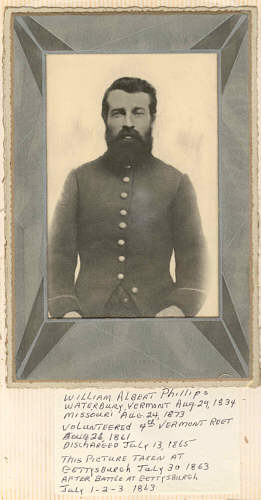 10 William Albert Phillips
|
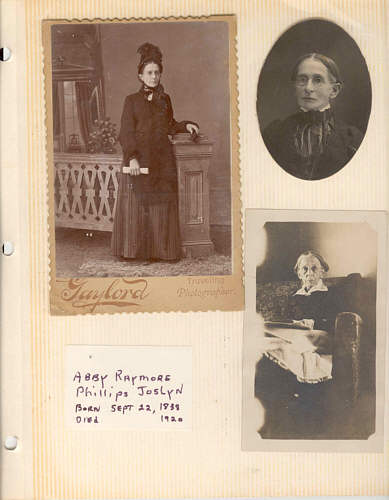 11 Abigail Raymore Phillips Joslyn
|
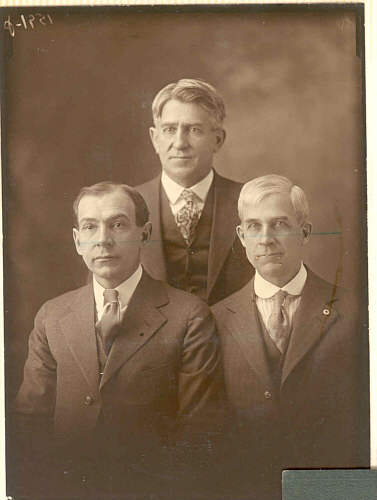 12 Archie Joslyn, William Albert Phillips Jr. John Henry Phillips brother of William
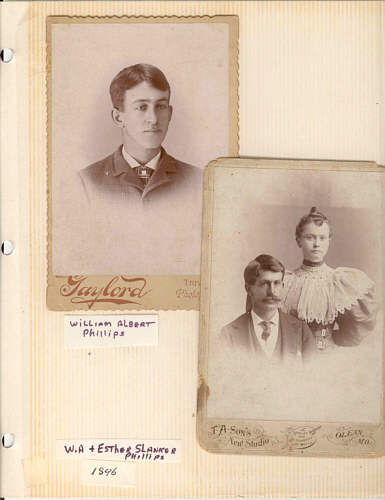 13 William Albert Phillips Jr. and wife Esther Slanker
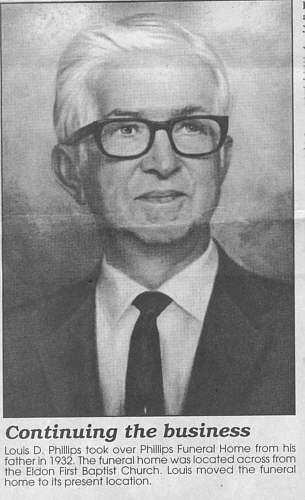 14 Louis Phillips
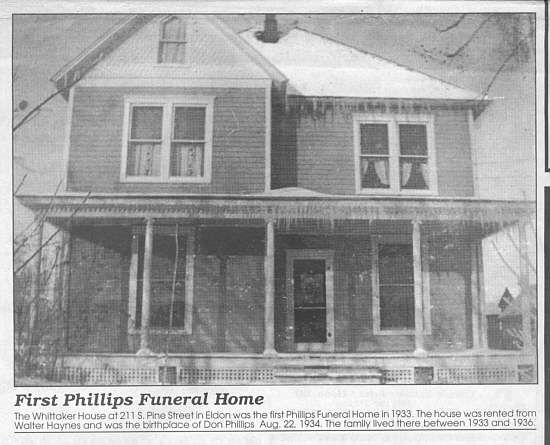 15 first funeral home Whitaker house
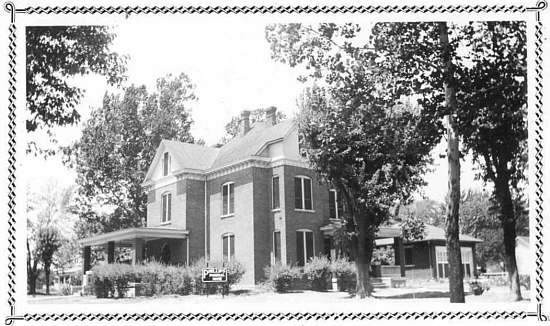 16 Harvey house
 17 W.A. Phillips Jr. obit Dec 23 1945
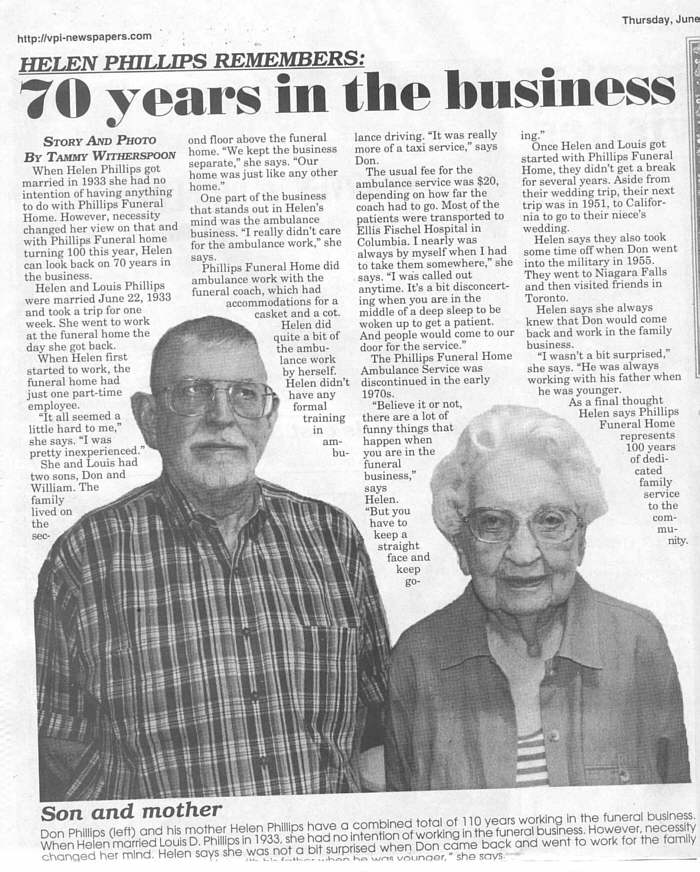 18 Don and Helen Phillips The Phillips' Funeral Home has been in operation for almost one hundred years including the time Louis's father, William Albert Jr. was alive. This family business is truly one of the historic institutions of Miller County. In fact, even before she met Louis, Helen remembers the day that William Albert Jr. came by horse and buggy during a snow storm all the way from Eldon to Tuscumbia to accept the body of Helen's father, Fred Fendorf (photo 19), who tragically had passed away at a very young age when Helen was only seven.
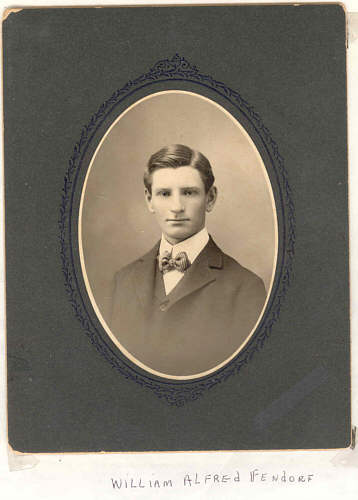 19 William Alfred Fendorf father of Helen Helen has many stories of the difficulties of the profession of the mortician including risk of disease. One incident stands out in my mind which she related. Years ago, one of the deceased persons that Louis and Don were called to receive for embalming was a man who had tuberculosis. Even though both Louis and Don took special precautions, unfortunately, both contracted the disease and had to spend several months in the sanatorium at Mount Vernon to be cured.
Helen also remembers well during the early days when she had to drive the funeral car (photo 20) for emergency calls to take people to the hospital. Many a night she recalls being awakened for the purpose of transporting the sick or wounded to the hospital.
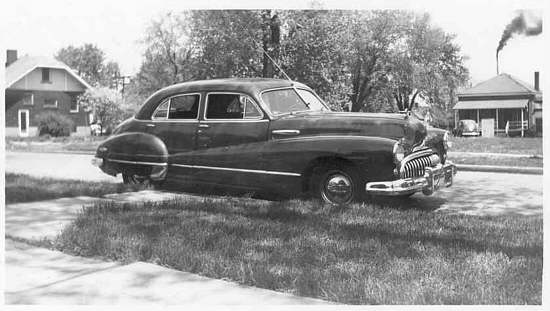 20 funeral car One of the memorable aspects the pubic remembers of Helen and Louis's operation of the Funeral Home was their attention to offering emotional support to grieving family members of the deceased. Both of them always were present to greet and offer support to relatives at the visitations and even after Louis passed away in 1978 (photo 21 obituary) she continued the custom herself of always attending to the needs of the families of those loved ones who had passed away and were lying at rest in the funeral home.
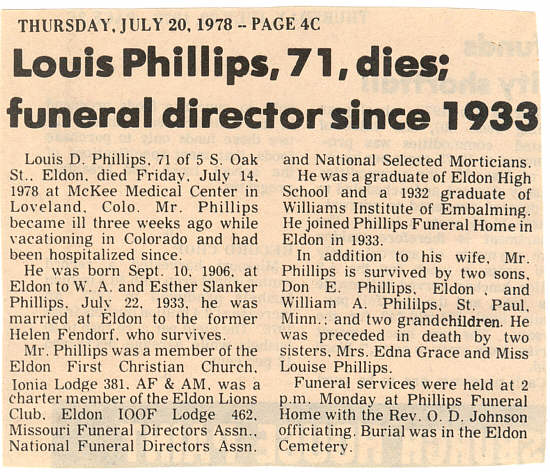 21 Louis Phillips obit The Phillip's Funeral Home celebrated one hundred years in operation last year which was heralded in a very interesting and complete section of the Eldon Advertiser last year (photo 22). The article was very well done and I recommend it to anyone who wants to learn the full story of the history of the Phillips Funeral Home of Eldon.
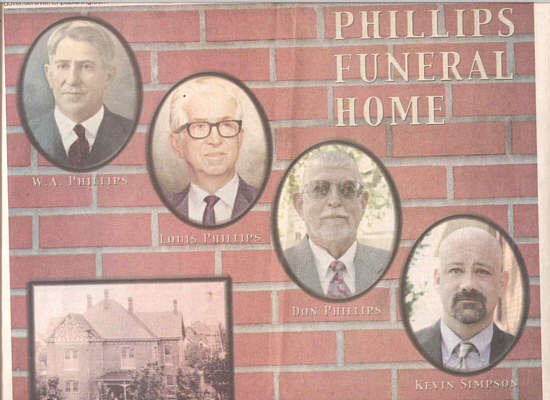 22 Eldon Advertiser William Phillips, the younger son of Helen and Louis, did not join in the operation of the funeral home because of his desire to travel. As a specialist in the area of Communications William has traveled and worked in the Middle East as well as Japan. One interesting outcome of his yearning to explore happened several years ago when he joined the staff of the University of Wisconsin-Steven's Point. Sometime after arriving there he discovered that Dr. John Phillips, a brother to his great grandfather, William Albert Phillips, had been a very well respected physician in the city and even had buildings and streets name after him. In addition, his great great grandparents were buried there as well (photo 23 of newspaper article). But Bill, as he is commonly known, told me last year when I saw him on a return visit home that family relations always have confused him a bit. For example, his best friend in school at Eldon was Bill Bear. Bill Bear's first cousin, Roy Stillwell, is a third cousin to Bill Phillips. But Bill Phillips never could understand then why his best friend Bill Bear and himself are not related.
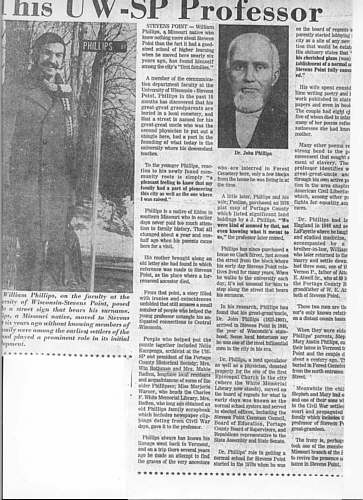 23 William in Wisconsin As noted above regarding William Albert Phillips Jr's trip to Tuscumbia by horse and buggy in a snowstorm, when the weather was bad in Miller County the people who had cars, which were not very many in the early part of the last century, had to resort to horse drawn means of travel. Postal Mail carriers often faced this choice. When I was growing up in Tuscumbia I remember talking to Wes Clark and Richard Wright who were rural carriers then and heard stories about how they always kept handy access to horse and buggy for the bad weather days. Matt Martin was the rural mail carrier for the Mill Creek route out of Brumley in 1916 (photo 24). (Notice in the photo that the mailbox is on a higher post than what was needed later when mail was mostly delivered by car.) The same need for travel by horse and buggy was true as well for physicians at times of foul weather. Those of you who read this page several weeks ago will remember that Dr. Edward Coleman Shelton of Eldon (photo 25) often used horse and buggy for transportation. Dr. Kouns of Tuscumbia never learned to drive a car, so when he needed to make a house call his chauffer always was Catfish Williams.I will have more to say about Catfish Williams and his brother, Friday Williams, in a later edition of this internet column.
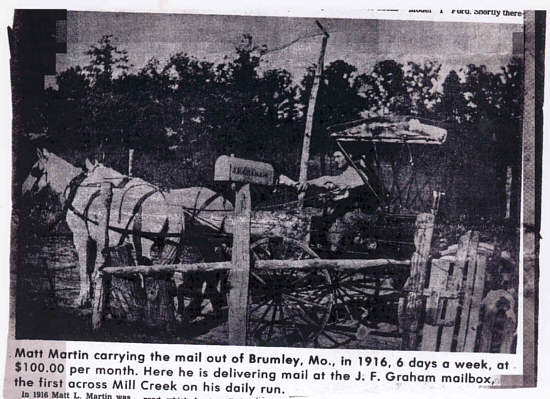 24 Matt Martin Brumley rural mail carrier
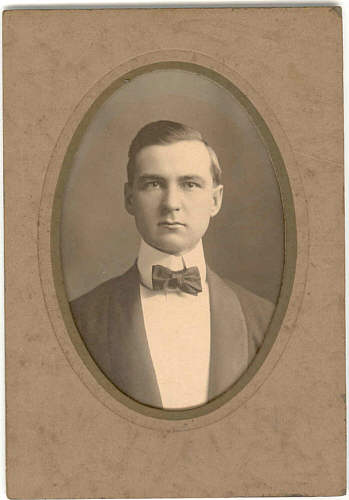 25 Edward Coleman Shelton M.D. When a car was used by mail carriers or doctors, it was usually the Model T Ford. Frank Thompson (or Thomson; I can't remember for sure, but both spellings have been used) had a garage in Tuscumbia early on and was one of the first Ford dealers of the area. The Model T was about the only model for sale then (photo 26). My Uncle David Bear describes a short commentary about this vehicle:
"Frank Thomson started selling Model T. Ford cars not long
before we moved to town. There wasn't much demand yet because
roads in the Ozark country were not suitable for cars. These
roads were made of dirt, dust, gravel and mud. On a short
trip in a car one expected to have a flat tire or two and maybe
get stuck in the mud. Tires of the day were very poor. Early
Model T. Fords had the gas tank under the driver's seat and
the gas flowed to the engine by gravity. Often a car would stall
while going up a steep hill because the engine was higher than
the gas tank. The remedy was to turn the car around, start the
engine and back it up the hill. Sometimes everyone had to get out and push the car. Always it was necessary that the gas tank be kept higher than the engine. Fuel pumps later solved this problem.
Another problem of these early cars was that they were cranked
by hand which could be hard work, and almost impossible to
accomplish on a cold day. I can tell you that Frank Thomson didn't sell many of these cars until after the mid twenties."
 Don't forget that Saturday, September 8 we will be having our Classic Car Show on the museum grounds in Tuscumbia featuring fifteen to twenty classic cars of many different makes. Jack Lupardus is in charge of the event and plans to bring his own classic Cadillac (photo 27). This show will feature classic cars of the fifties and sixties. Don't forget that Saturday, September 8 we will be having our Classic Car Show on the museum grounds in Tuscumbia featuring fifteen to twenty classic cars of many different makes. Jack Lupardus is in charge of the event and plans to bring his own classic Cadillac (photo 27). This show will feature classic cars of the fifties and sixties.
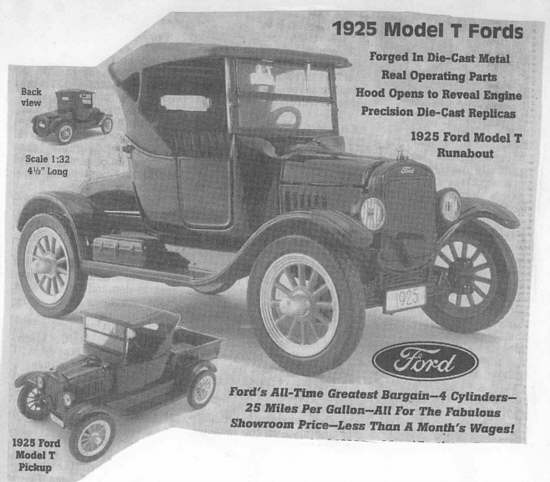 26 1925 Ford
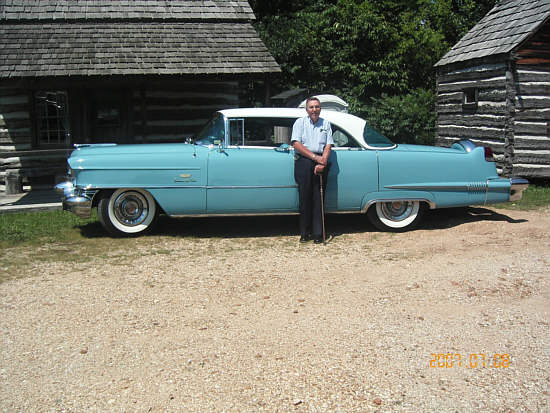 27 Jack Lupardus,Classic Cadillac I have another photo this week of an old log cabin in Miller County (photo 28). This one was built by some kind people of the Tuscumbia area for a man named John Varner and his ailing mother. They were very poor at a time when the country was in a deep recession in the late 1920's or early 1930's having to go from place to place to live barely having enough food. I don't know the complete details of their story nor what eventually happened to them after the house was built although I was told that Mrs. Varner died soon afterward. The log house was located on the old Tuscumbia Versailles road about a mile south of the junction with highway 52. I passed by it frequently as a youth when our family was going to visit my mother's cousin, Frank Martin. The cabin is still standing although in some disrepair. For a period of time my Uncle David Bear owned it for the purpose of having a place to stay when he returned home to Tuscumbia to visit since his mother (my grandmother) was an invalid with Parkinson's Disease and could not host guests in her house. This photo of the log house was taken in the late 1950's by Uncle David.
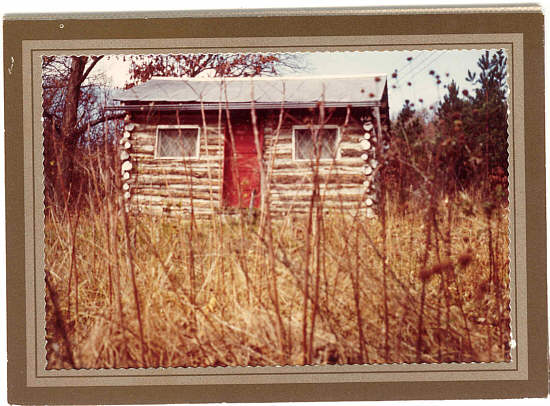 28 log cabin tuscumbia versailles road built by neighbors for Mrs. Varner early part of last century
This week, Arthur and David Bear (photo 29) discuss medical care in the first part of the last century. Due to the length of this discussion part one will be offered this week and part two next week:
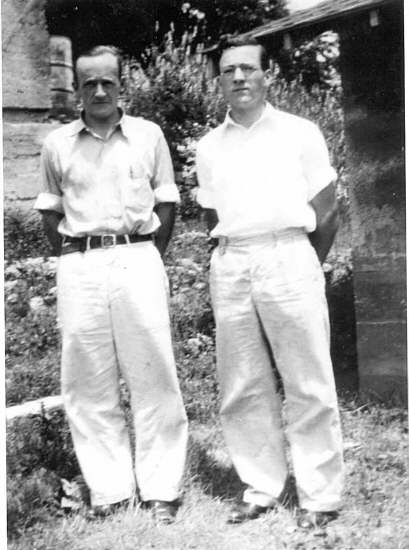 29 Arthur and David Bear David: Another area in which we have seen a great transition
has been in the area of medicine and medical services. In the old days, if you got sick you stayed at home and took care of your
sickness. If you went to a doctor in town, he would probably
give you some medicine, and make it for you out of some bottles
of stuff (photos 30 and 31) he had on hand, or he would send you home with some pills. At least you felt better in knowing that you were being doctored. The nearest hospital was 35 miles away in Jefferson City which was quite a distance in those days. People tried to ignore the hospital because of the distance and the expense.
There was no hospital or medical insurance back then. The
practice of medicine was very primitive. Doctors had almost
no effective medicines. Antibiotics hadn't been developed yet.
Sulfa drugs came on in the late thirties to early forties.
Penicillin arrived in the early forties while I was in World
War II. The armed services got priority. So prior to the
develpment and distribution of these drugs, your body had to
do all the fighting against infections. About the only thing
a doctor or a loved one could do was to make the patient
comfortable and ease the pain with aspirin which was available.
If the occasion called for it, the doctor could use morphine
to ease the pain. Bootleg whisky was also used for courage
and pain killing. Ether was available as an anesthetic when
surgery was called for. Childhood diseases were rampant in the
early days of the century. Vaccinations were not available
for such things as diphtheria and whooping cough. Smallpox
vaccinations did exist, but many people didn't get them. There
was very high infant mortality with no effective means of
treating childhood diseases. Diphtheria and whooping cough
killed many children. I can recall, in my case after we moved
to town, perhaps about 1925, that I contracted typhoid fever
and was sick for many weeks. My body did all the fighting, yet
I had good care from Mom, and Doc Kouns came about two times
a day. Later when I was about 20 years old, I got lobar
pneumonia, and again my body did all the fighting without the
aid of antibiotics. Pneumonia was the great killer of this
time, and a person was fortunate to survive it. Pneumonia went
through a predictable cycle. If a person survived to the ninth
day, he had reached the climax where he would either get better
or go to meet his ancestors. I disappointed either my ancestors
or my family because I started getting better. My fever broke
and I became more rational, but there was still a long period
of recovery ahead. The body needed much time to bounce back.
There was a lot of folk medicine and patent medicines available.
I suppose, Arthur, that you remember quite a bit about some
of the remedies that some people believed in.
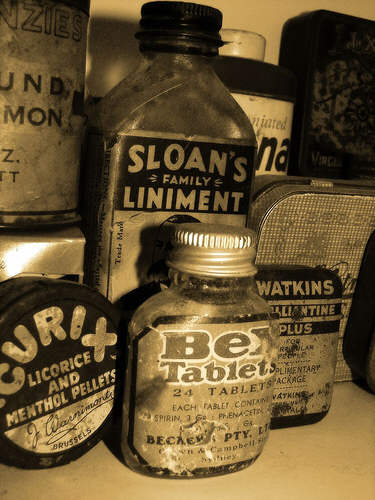 30 old medicine bottles
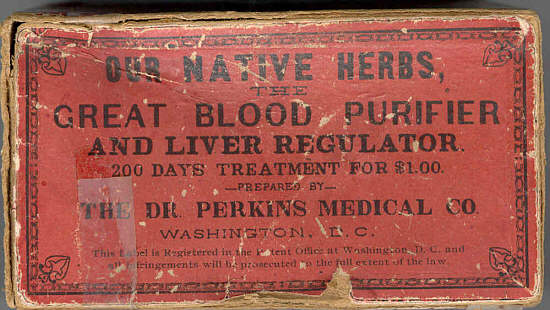 31 Patent Medicines Arthur: Well! We took a lot of stuff like Black Draught, a
strong laxative (photo 32 ), bromo quinine, "chill tonic"(photo 33) and calomel tablets (photo 34).
 32 Black Draught old sign
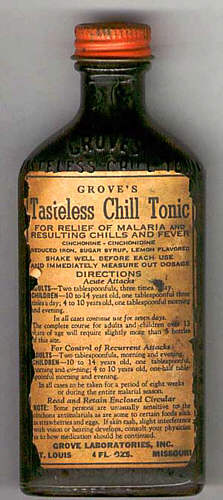 33 Groves Chill Tonic
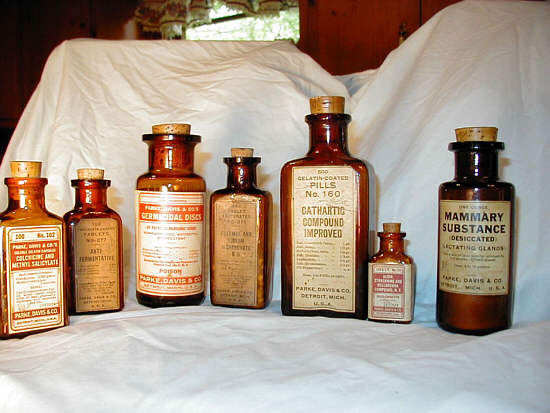 34 calomel and other cathartics David: Chuckle, chuckle. Did you ever take a round of calomel?
Arthur: Oh! You bet, and you had to work it off with either
a dose-of epsom salts or a 2 ounce bottle of castor oil. One
was about as bad as the other.
David: Now, I don't know why people got the idea that calomel
was effective; however, doctors prescribed it. I don't even
know what it is.
Arthur: I don't either. People don't use it now days.
David: I think it was a compound of mercury.
Arthur: Occasionally they would look at your tongue. If it
had a white, gray coating, well, you were bilious, and that
demanded a round of calomel for two or three days. I never
knew at that time what bilious was, but I sure didn't want it. I believe it was for a longer period than that.
I don't know how many of the little pills we took per day, but
the treatment lasted about one week. During that time we had
to refrain from certain activities or something dreadful would
happen to us.
Arthur: Yeah! You'd get salivated, whatever that was. "Chuckle"
David: I guess it means an overproduction of saliva, but when
I was young, that big word scared me. I didn't know the meaning
of the word, but it sounded ominous.
Arthur: I took a chance once. I took a round of calomel when
I was five years old and we lived on Cattail Creek. Angie Weitz,
our next farm neighbor was staying with me while Mom had gone
somewhere. She had instructions about my problem, so she fixed
me up a large dose of epsom salts 'cause it was time for my
purgative to work it off. She gave me a glassful of it and went
out in the other room and I pitched it out in the back yard.
I don't remember getting salivated.
David: Well, I don't blame you, but I probably wouldn't have
had the nerve to do it. It was horrible tasting stuff. They
believed then that medicine couldn't do you any good unless
it had a bad taste. Castor oil is not the greatest tasting
stuff in the world, either, Another alternative was senna tea
which was believed to be another strong laxative to work off
the effects of the calomel. Well! this was a medical treatment
that I'm sure didn't help either kids or adults, but it made
the parents feel that they were taking care of their "younguns."
And then, there were other old wives tales or folk medicine.
One lady commented that Mom give one of the kids some hen-
manure tea. Thankfully, Mom didn't recognize the curative powers
of this potent stuff. Maybe she should have tried it on Arthur.
Remedies like this would sometimes be used by poorly informed
people. There was always at least one faith healer in a
community. Mal Wyrick claimed to be able to cure certain things
on both man and beast. When a person had warts, he was often
told to go see Mal. I don't know whether he used chants.
His wife, Jenny Wyrick, had her own ideas about healing. She
ran the county poor farm to take care of paupers.
Jenny was a midwife too wasn't she. Arthur?
Arthur: Uh. huh, Yeah.
David: Jenny was one of the characters that I remember, and I know that Arthur remembers her as well, isn't that right Arthur?
Arthur: Yes, she was quite a character. She was one of a kind. She was stern and commanding and you didn't argue with her.
David: She could stand up to any man and stare him down.
In terms of medicine, you were talking earlier about Jenny coming by our farmhouse one night wanting to borrow a lantern. Would
you relate that again, Arthur?
Arthur: Well! She came by one night when I was about six years old. It was dark and I guess her coal oil lantern had gone
out, and she was going to one of the neighbors to deliver a
baby. She stopped at our house and wanted to borrow our lantern. Dad had gone out to her buggy to talk to her, and I was standing
at our front door. I could hear what they were saying, and I yelled out "Dad don't you let Jenny Wyrick have our lantern." She said, "Arthur Bear you'd best get back in the house or I'll twist your tail!" That was the kind of woman she was. Once she gave Ray Wickham a real tongue lashing. She thought Ray had stolen her egg case. He hadn't I don't think because all egg cases looked alike, but Jenny wasn't afraid of Ray, so she let him have it. Well, of course, Ray was pretty influential in the community and was president of the Board of Directors of the Farmer's Exchange. But Jenny wasn't afraid of man nor beast and she spoke what she pleased.
Next Week Arthur and David will continue their discussion in part 2 about the doctors and medicine of the past. In the meantime, take a look at this website (click here) which lists many of the medicines (by their labels) being sold by drug stores in those days long ago about which Arthur and David are discussing. These patent medicines often times were sold without a prescription or passed out by quack doctors who traveled a circuit but had no license.
On the subject of the early doctors in Miller County it should be noted that most were fine upstanding men of the community and were as well trained as the education and training that those times could provide. One of those doctors was Logan Allee M.D. who practiced many years in Eldon. We have some of his medical instruments as well as his doctor's case on display at our museum in the medical section. Included here are photos of the old medical bag and the instruments (photos 35 and 36).
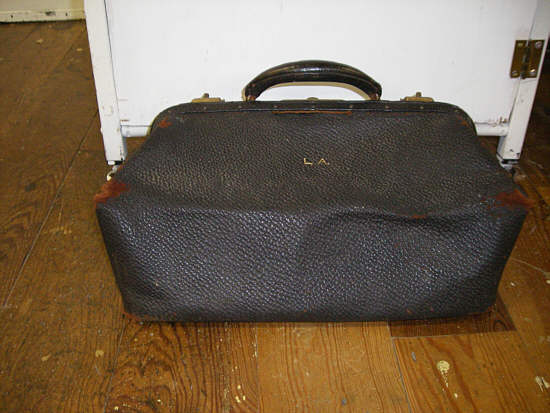 35 Logan Allee Medical Case
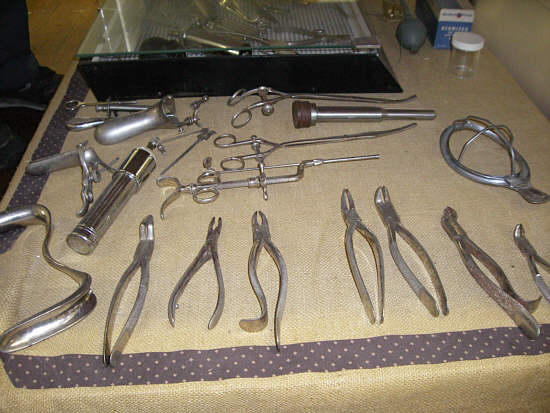 36 Logn Allee medical instruments Our revolving display in the research room this month as arranged by board member Sharon Cogdill highlights the Miller County community of Olean (photo 37). We want to especially thank Betty Roark (photo 38) for supplying many of the photos and much of the information for this display.
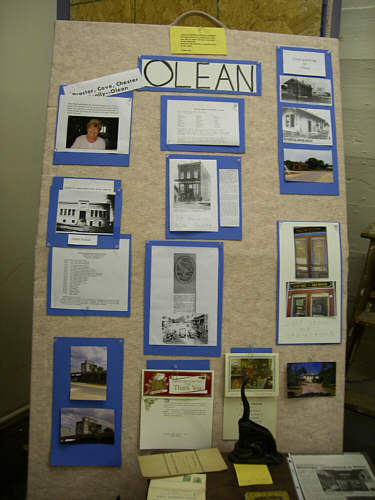 37 Olean display
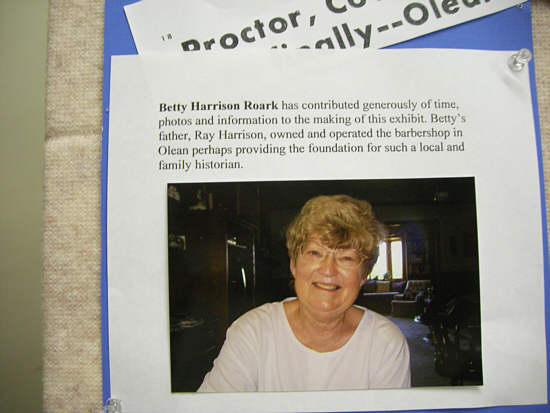 38 Betty Roark The unusual looking item for this week is pictured in the photograph below (photo 39).
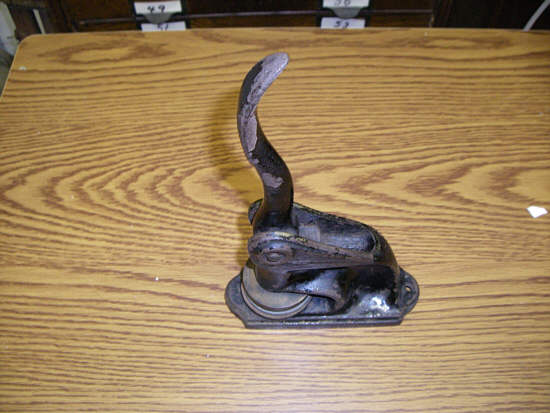 39 what is it It is an official stamping device which was used by the Olean School system for many years. This item is part of the Olean display now showing in our research room.
A few weeks ago I uploaded an old photo of a group of men of the Faith community holding various types of shotguns (photo 40). I sent the photo to an expert on the subject, Michael McIntosh, who kindly responded as follows:
"As to the photo you sent, I think I can identify only a couple of guns. The hammerless gun in the front row looks like an early Ithaca, and the single-shot is very likely an Iver Johnson. The hammer guns are impossible to identify. At that time and place, they were most likely Belgian, because Belgian guns were both inexpensive and plentiful. It was common at that time to be photographed with your most valued possessions. For men, that usually meant guns. The banjo suggests one who prized music above all else. I'd bet the old chap with the foot-long white chin whiskers and sword was a Civil War veteran."
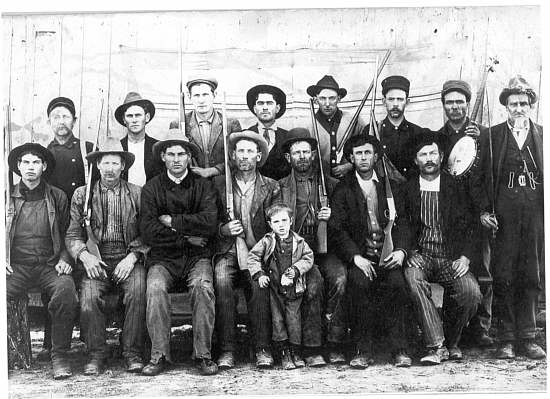 40 Posing at Faith Michael is a very well known author on the subject of fine shotguns the world over. He was the gun editor of our own state magazine "Missouri Conservationist" for several years back in the 1980's. Since then he has written many books on the subject of shotguns (the one most frequently quoted is "Best Guns") and now is a columnist for the magazine "Shooting Sportsman". You can order any of his many books online from sources such as Amazon.com. I became friends with Michael almost twenty years ago and we have gone on several shooting trips together (photo 41).
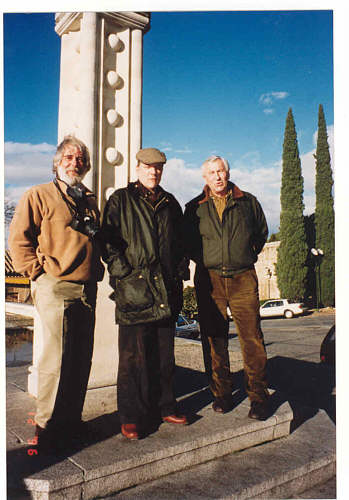 41 Michael McIntosh, Joe Pryor, Jack Jansma I received a second photo (photo 42) of the men at Faith from Peggy Hake with contributions by Lewis Wall in which the names of the men in the photo are added. It wasn't easy to identify some of them and I admire the detective nature of these two members of the Miller County Historical Society which makes the photo even more interesting (especially if you find your family name!).
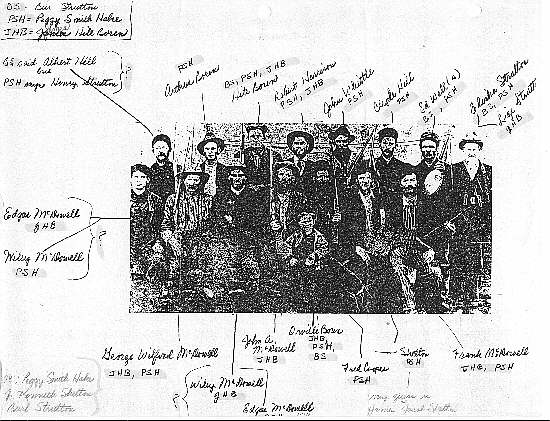 42 Men at Faith Saturday of last week we were delighted to meet the Ferguson family (photo 43), descendents of Squire John Ferguson of Iberia, who came to visit our museum and to acquire some historical records regarding their famous ancestor. Squire John was from Scotland and lived in the Iberia area from the middle part of the 19th century until his death in the early 1930's when he was in his nineties of age. Squire John served with the Union Army in the Civil War. He was always a colorful character and in later years sported a bushy white beard. The photo included here with his wife was taken when he was yet a young man (photo 44). Squire John often was asked to officiate important ceremonies such as the Miller County Centennial in 1937 and the opening ceremony of the present bridge across the Osage River in Tuscumbia in 1931.
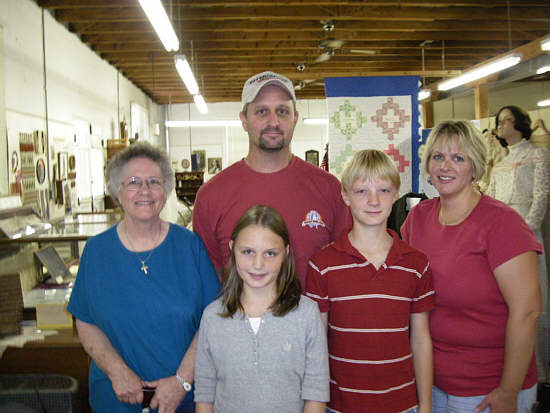 43 Ferguson Family Sharon,Scott,Anna,Ehtan,Paula Ferguson
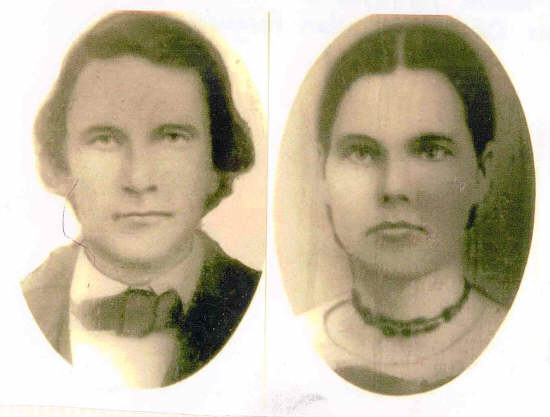 44 John Ferguson and wife That's all for this week. I will be away from the computer for a few days since the dove harvest season begins tomorrow which will keep me busy for awhile. But I'm sure I will think of something to write about while I'm away from the desk.
Until later thanks for dropping by the Miller County Museum website and for visiting the President's Page.
That's all for now.
| 


